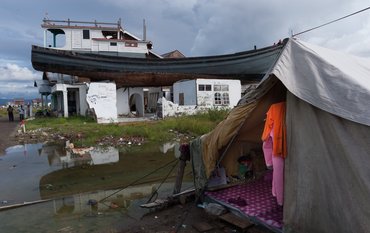Summary
Over geologic time, the CO2 concentration in the atmosphere and, thereby, Earth's climate is significantly influenced by rock weathering at Earth's surface, because these chemical dissolution processes result in both the release and capture of CO2 – depending on the mineral. A team led by Aaron Bufe from LMU Munich and Niels Hovius from the German Research Centre for Geosciences (GFZ) and the University of Potsdam has investigated how erosion and weathering influence the CO2 balance over millions of years. Their model calculations show: CO2 sequestration through weathering is maximised at a moderate erosion rate. Surprisingly, CO2 capture through weathering reactions is highest in low-relief mountain ranges with moderate erosion rates – and not in high mountain ranges with stronger uplift, where erosion rates are fastest. The results have now been published in the journal Science.
Background: The influence of erosion and weathering on the capture or release of CO2
For many hundreds of millions of years, the average temperature at the Earth's surface has varied by less than 25 degrees Celsius, facilitating life to develop on our planet without interruption. To maintain these conditions, Earth must have a ‘thermostat’ that regulates the concentration of atmospheric carbon dioxide over geological timescales. The erosion and weathering of rocks are important parts of this ‘‘thermostat’.
When rocks are exposed by erosion to wind and weather, they are being weathered. “These chemical dissolution processes take place very differently and at different velocities depending on the mineral,” explains Niels Hovius, head of the Geomorphology Section at the German Research Centre for Geosciences GFZ and Professor at the University of Potsdam. When silicates weather, for example, carbon is removed from the atmosphere and later precipitated as calcium carbonate. By contrast, weathering of other phases – such as carbonates and sulfides or organic carbon contained in rocks – releases CO2. However, these reactions are typically much faster than silicate weathering.
“Therefore, the effect of erosion and mountain building on the carbon balance is complicated,” says Aaron Bufe, Professor of Sedimentology at the Ludwig Maximilian University of Munich and previously post-doc scientist at the GFZ.
New insights into the competing weathering processes
Basically, the rates of the chemical dissolution processes are, to first order, controlled by erosion and thus by the supply of fresh minerals into the weathering zone, as well as by the availability of reactive fluids and the dissolution kinetics of the respective mineral.
“Understanding how weathering rates are influenced by tectonic and climatic boundary conditions is of crucial importance for modelling the Earth's evolution over geological time and for assessing the response of the Earth system to natural and anthropogenic disturbances,” says Niels Hovius.
In order to gain insights into the competing processes and their impact on the CO2 balance, Aaron Bufe and Niels Hovius, together with Jeremy Rugenstein from Colorado State University, USA, analysed data on the extent of sulphide, carbonate and silicate weathering in a number of targeted study regions with well known, large ranges in erosion rates. They used four data sets containing concentrations of dissolved solutes in mountain streams with relatively uniform siliceous metasedimentary rocks. Three data sets originate from southern Taiwan, the eastern Tibetan Plateau in Sichuan and the Southern Alps of New Zealand. The fourth is a global compilation of bedrock mountain streams, serving as reference.
Weathering model shows common mechanisms in different regions
For each data set, the researchers estimated silicate, carbonate and sulphide weathering fluxes based on solute concentrations and runoff.
On this basis, they used mathematical weathering models to determine how the weathering of the respective rock reacts to changes in the erosion rate. They fit a widely used model that describes chemical weathering fluxes from eroding landscapes as a function of the erosion flux and climatic parameters such as runoff and temperature.
“We observed similar behaviour for all locations, which points to common mechanisms,” says Aaron Bufe.
CO2 capture reaches maximum at medium erosion rate
Further modelling showed that the relationship between erosion and the CO2 balance is not linear: more erosion does not automatically lead to more CO2 capture. Instead, CO2 capture reaches an optimum at an erosion rate of around 0.1 millimetres per year. At both lower and higher rates, less CO2 is sequestered or even increasingly released due to weathering.
“High erosion rates, such as in Taiwan or the Himalayas, drive the system towards a CO2 source, because the rapid, CO2-releasing weathering of carbonates and sulphides continues to increase, while the comparatively slow, CO2-binding silicate weathering can no longer increase with increasing erosion rates because the material is removed by erosion faster than it can weather,” explains Bufe.
“In landscapes with moderate erosion rates of around 0.1 millimetres per year, on the other hand, the rapidly weathering carbonates and sulphides that release CO2 are quickly consumed, while the slower silicate weathering can continue and draw down CO2. The net effect is CO2 removal at maximum rates.”
In landscapes with little topography and uplift, where even less material is removed, there is ultimately little left to weather.
Largest CO2 sinks in low mountain ranges
The largest CO2 sinks are therefore low mountain ranges such as the Black Forest or the Bavarian Forest, where erosion rates are close to the optimum. “This concept of an ‘erosion optimum’ for CO2 drawdown reconciles conflicting views on the impact of mountain building on the carbon cycle and permits estimates of geologic CO2 fluxes dependent upon tectonic changes,” summarises Niels Hovius.
Aaron Bufe adds: “Over geological timescales, the temperature to which Earth’s ‘thermostat’ is set therefore depends strongly on the global distribution of erosion rates”. To understand the effects of erosion on Earth’s climate system in greater detail, Bufe thinks that future studies should additionally consider organic carbon sinks and weathering in floodplains.
Original publication:
Aaron Bufe, Jeremy K.C. Rugenstein, and Niels Hovius: CO2 drawdown from weathering maximized at moderate erosion rates. Science 2024. DOI 10.1126/science.adk0957
External scientific contact:
Prof. Dr. Aaron Bufe
Department für Geo- und Umweltwissenschaften
Ludwig-Maximilians-Universität München (LMU)
Telefon: +49 (0) 89 2180 6714
E-Mail: a.bufe@lmu.de
Website: http://www.aaronbufe.com
















![[Translate to English:] [Translate to English:] Abror Gafurov von dem Schriftzug "Welcome to Azerbaijan" und den UN und COP Logos](/fileadmin/_processed_/2/5/csm_2024_11_Baku_COP29_Abror_Gafurov_1042faec82.jpeg)


![[Translate to English:] Martin Herold standing in front of the library on the Telegrafenberg](/fileadmin/_processed_/c/d/csm_Martin_Herold_d385ee4dd9.jpeg)
![[Translate to English:] Many people are listening to a presentation in the GFZ lecture hall.](/fileadmin/_processed_/c/a/csm_1_Bild1_hell_b9c0e9f5ed.jpeg)






![[Translate to English:] Both scientists sitting on stools in front of a wall of books in the Telegrafenberg library](/fileadmin/_processed_/6/6/csm_Buiter_Castell_DORA_4_e87cb1ea18.jpeg)
![[Translate to English:] Gruppenbild mit 4 Personen](/fileadmin/_processed_/8/d/csm_20241017_GFZ-Emmerman-Medal-005_web_reinhardtundsommer_21a414fa4a.jpeg)






![[Translate to English:] Ice landscape with five red tents](/fileadmin/_processed_/8/9/csm_Zeltlager_auf_dem_Eis_Urheberin_Jenine_McCutcheon_5ced2d523b.jpeg)

